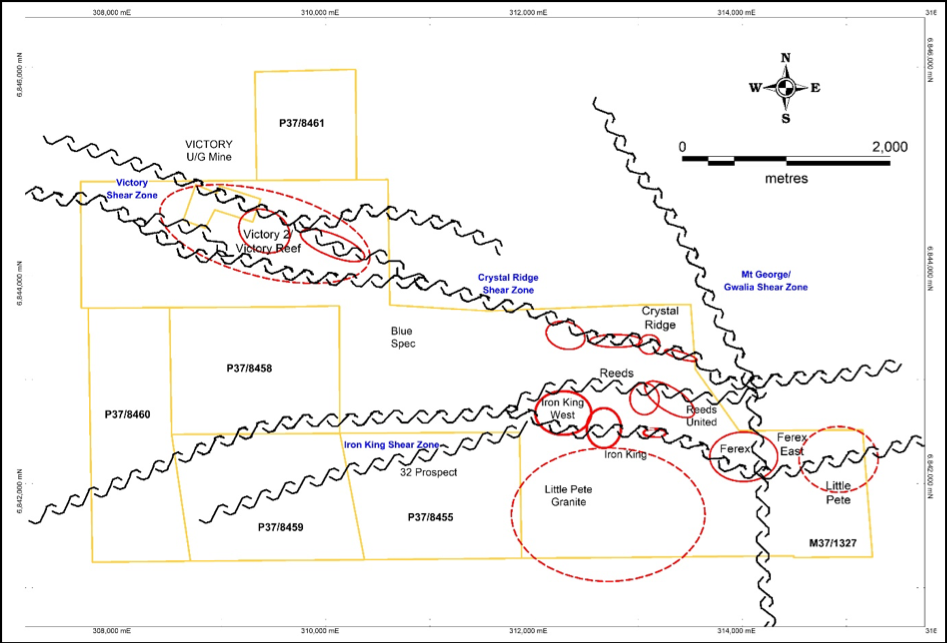The Iron King Project is located in the Mt Malcolm District of the Mt Margaret Mineral Field in the centre of the North Eastern Goldfields 50km NNW of the township of Leonora. The Project is approximately 14km NW of the King of the Hills Gold Mine (Tarmoola) and 15km SW of the Teutonic Bore (Cu-Pb-Zn-Ag) mine.
The Iron King area lies directly along strike of the NNW trending Gwalia Shear Zone (GSZ) that hosts the Sons of Gwalia Mine (+11Moz Au) and the King of the Hills (formerly Tarmoola) Gold Mine (+4Moz Au). Gold endowment along the 35km long stretch of the GSZ linking these two major gold mines is estimated to total in excess of 15 Moz Au.
Tenement (M37/1327) represents the central and largest holding of the Iron King Project, covering an area of 1,164 ha, coupled to a contiguous group of 5 PL’s (P37/8455, 8458-61) covering 898 ha.
The Project area overlies the eastern flank of the Tarmoola Anticline positioned between the Clifford Fault, to the east, interpreted to represent the northern extensions of the Mt George Shear/Gwalia Shear Zone, and the Minnieritchie Fault to the west. The refolded Archean greenstone sequence is comprised of a highly deformed and complex East-West to WNW trending sheared and tightly folded metamorphosed greenstone sequence that has been intruded by numerous granitic intrusions, porphyries and disjointed Proterozoic mafic dykes. The underlying greenstones encompass a suite of easterly trending tholeiitic (mafic) and high-magnesian basalts, felsic volcanics, interflow sediments including shale, chert and iron formations, felsic and mafic intrusives and ultramafic rocks.
The layered greenstone succession is intruded by numerous felsic porphyries and several stocks, dykes and sills, commonly of granitic origin which are often magnetic. The numerous granitic sills are associated with the Little Pete magnetic granite which outcrops at Victory Corner Well and tenements further east. On a regional scale, the layered Archean greenstone sequence is intruded by two, closely related, east-west trending late stage Proterozoic dolerite dykes.
The structure at Iron King is extremely complex due to a combination of faulting, shearing and tight folding coupled with granitic intrusives. The area is dominated by several WNW to W trending narrow shear zones, that are components of the Iron King Shear Zone. The shears separate blocks of felsic and mafic and ultramafic rocks which are the host rocks for gold mineralisation at the Victory and Iron King mines. The shears are associated with the complex break-up of the Mt George shear system to the east and associated with gold mineralisation at Victory, Blue Spec and Iron King. Anomalous gold values occur along the entire length of the shear system are all associated with historic gold workings.
The tenement area encompasses the historic high-grade Iron King Mine, Blue Spec Mines and the eastern strike extensions of the very rich excised Victory Mining Lease (M37/1322) which boasts historic production at a grade of 95.6 g/ Au. The eastern strike extensions of the Victory lode are evident over at least 800m on M37/1327 prior to disappearing under cover. The principal target commodity within the Iron King greenstone sequence is Gold (Au) however Base Metals (Cu, Pb, Zn, Ag) are also interest.
Locally pre 1954 production figures from producing Iron King GML’s include:
- Blue Spec – 177 tonnes @ 56.6 g/t Au for 322 ounces of gold.
- Victory – 3,726 tonnes @ 95.6 g/t Au for 11,638 ounces of gold.
- Iron King – 96.6 tonnes @ 23 g/t Au for 68 ounces of gold.
Historical prospecting has shown that the mineralisation at Victory and Iron King extends for several hundreds of metres along strike at both locations. No effective modern exploration has been carried out away from the historic Victory Mine and limited exploration has been completed at Iron King. Evidence of similar styles of gold mineralisation is also observed at Ferex, Crystal Ridge and Reeds United. Target specific, modern exploration is required to fully evaluate the mineralised potential of these areas.
Additional geological investigation including mapping and close spaced soil geochemistry is recommended to fully evaluate the historical results.



